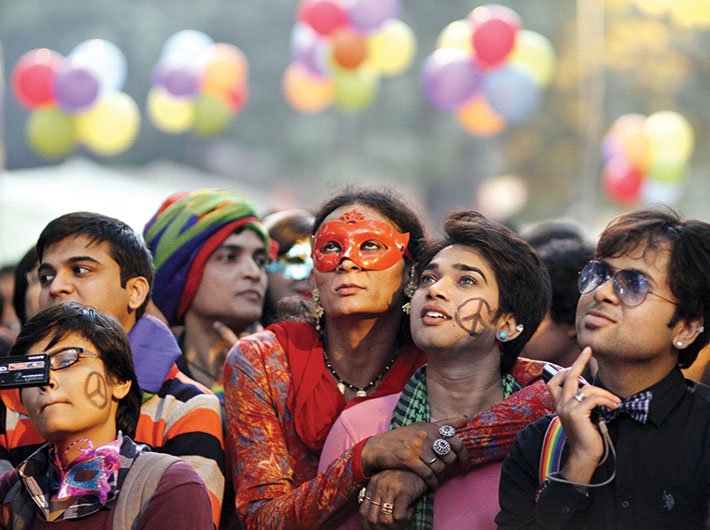So that no one can be questioned, stared at, looked down upon or left in isolation based on where one falls on the gender spectrum
Since childhood I never felt like a girl. I was always an outsider among girls and never mingled with them. Initially, I thought I was a tomboy. I used to indulge in boyish activities with my brother. I did not question my gender at that young age, but as I grew up and started getting bodily changes like other females of my age, I never came to terms with them,” shares Duncan Kingsley, a 25-year-old transboy from Tamil Nadu.
“I was uncomfortable with my body, I wanted those changes to stop. If someone would give me a compliment over my appearance, I felt disgusted. I felt this is not my real body. An inside voice would suggest that something was different with me. I was scared all the time and despite the discomfort in a female’s attire, I used to wear those dresses as asked by my parents. I was confused whether I was doing it for the sake of my parents or myself. I fell into depression eventually,” says Kingsley who hasn’t opened up to his parents regarding his gender identity yet.
After struggling till 20 years of age, Kingsley decided to suppress all feelings, doubts and discomfort and started researching on transgender and transsexuality. It took him two years to finally accept himself. “At first I thought I was crazy. I didn’t want to accept this fact but later on I chose freedom and finally switched to masculine attires and cut my hair short. I started feeling better and happy. I was no longer scared of anything,” he says.
Gender is a complex phenomenon that constitutes a person’s identity and how one wishes to express it through clothing, communication, patterns of behaviour and so on. It is a huge spectrum of multifaceted gender identities that goes beyond the socially prescribed categorisation (male and female). These identities – transgender, genderqueer and intersex – being minorities in India face constant harassment and discrimination.
Gopi Shankar, an intersex genderqueer from Madurai who has founded Srishti Madurai, a literature research and resource circle for LGBTQI (Lesbian, Gay, Bisexual, Transgender, Queer and Intersex), says, “Gender is defined based on biological, psychological and sociological aspects. There can be no accurate statistics on the number of people in gender minorities because there is no gender verification or determinant for defining a gender. It is necessary to educate bureaucrats, politicians, medical faculty and lawmakers about gender minorities’ issues,” Gopi says.
“We talk about female feticide but we don’t focus on intersex infanticide. If a child is born with irregular or ambiguous genitalia, some doctors perform surgeries to make them female or male. How can you change the gender of a person? You can alter the visibility of their reproductive organs, but you cannot alter their mind,” says Gopi. Ze (that’s the gender-neutral pronoun some members of the community prefer) has conducted more than 85 seminars on gender and sexuality for 8,000 students and also coined Tamil terms for genderqueers.
Himadri Roy, from the School of Gender and Development Studies, IGNOU, says, “If you see a man dressing like a woman and moving around copying the way transgenders or hijra community behave, you think this man is a hijra. Physical representation becomes very important. There are queer people who behave in a man’s way and in a feminine way. These two degrees of behaviour varies which is not at all camouflaging with the way transgenders behave. These kinds of differences draw a line between transgenders and genderqueer.”
A ray of hope
The Rajya Sabha, in April, passed a private member’s bill to provide and protect rights for transgenders. The rights of transgender persons bill, 2014, moved by DMK MP Tiruchi Siva, deals with their education, skill development, employment, social security, rehabilitation, medical, legal and financial aid among other things.
This move comes a year after the supreme court granted third gender status to transgenders following a petition filed by National Legal Services Authority (NALSA). By virtue of this decision, all identity documents, including birth certificate, passport, ration card and driving licence, would recognise the third gender.
Though it has been decades since the last private member’s bill was passed by parliament, Tiruchi Siva, a Rajya Sabha member, is hopeful. “I don’t believe that any one will oppose it (in Lok Sabha) because it is a social cause. If the bill gives birth to an act it will throw light into the dark lives of these people.”
Beyond the third gender
“I don’t like the term ‘third gender’. All people in the transgender community, whether they are hijras, kinnars or aravanis, are old cultures and not just genders,” says A Revathi, a prominent hijra activist from Bengaluru who is popularly known as the ‘mother of all transgenders in India’. According to her, the most important thing for parents is to accept their children regardless of their children’s gender identity. “In India, people think that all transgenders are hijras whose work is to dance and sing at ceremonies. Transgenders are very talented and intelligent and they should get equal opportunities as the mainstream and not under any third gender category,” she says.
The bill and the NALSA judgment have paved way for further opinion and debate. Bittu Karthik, a genderqueer transboy, who teaches neuroscience at the Hyderabad university says, “The problem with the NALSA judgment and the bill is that many people from gender minorities do not identify themselves as third gender. Some transgender men identify themselves as men and some transgender women identify themselves as women, and the whole fight is to be accepted in the gender identity that they have chosen. They don’t want to be pushed into a third category. But the only way people can take benefit of these measures in the bill is when they identify themselves in the third category, which is very small in number. I personally oppose gender-based categorisation. To be in a position to choose a gender category produces intense ‘dysphoria’ in me,” Karthik says.
“Changing my personal identity will not change how people treat me in society. It will help me for official purposes, that it’s clear that I am transgender, but I will always be open to harassment from society. The primary reason why I am in a position to teach in a university is that I haven’t physically transitioned or changed my name and gender officially. Change for the community doesn’t end with the law. It might start with it,” ze adds.
Speaking about cross-dressing ze says, “There is no correlation between clothing and a gender. It is a personal choice. Dresses that are considered to be meant for male and female differ at different places. Hence this whole system of gender category is ridiculous.”
Kalki Subramaniam, a transgender rights activist and the founder of Sahodari Foundation, says, “I’m a transgender woman but I don’t belong to the hijra community. I respect them a lot, but I don’t follow their culture. And I definitely don’t consider myself belonging to a third category. People’s own gender identity should be recognised. Third gender should be an option,” she adds.
Health care is a concern
Gopi Shankar is apprehensive about medical services that will be provided as prescribed in the bill. “In the bill, transgender is an umbrella term for all genderqueer and intersex people. However, the medical services are available only for binary transgenders (transmen and transwomen) for transitions. But genderqueer identified transsexuals need special medical services which are not available in the country,” Gopi says.
“The non-binary transsexuals (neutrois) are only left with the choice of not transitioning or transitioning to a binary category. Many genderqueers are not aware that they are genderqueer. Systemised and organised research work on such people and their issues is almost non-existent in the field of medicine, psychology, humanities and social sciences. Schools of gender studies and social studies focus mainly on male and female issues or sometimes the hijra community. We cannot use the word transgender or hijra to denote all gender minorities.”
According to Rachana Mudraboyina, a transwoman and a co-founder of the Telangana Transgender Hijra Intersex Samitti, the bill has been promoted by Tamil Nadu activists who are the pioneers for transgender welfare. “Though the NALSA judgment says that all states must have a transgender welfare board, only Maharashtra, West Bengal, Karnataka and a few others have done so,” she says.
Identity crisis
Though the bill is promising, most people from gender minorities are apprehensive about losing their identity with it. For example, there is no clarity on how they will deal with their previous identification cards that contain their old photographs and names in the gender they were assigned at birth. It inhibits them to get gender reassignment surgeries and have no other option than to go with third gender category on papers. It might help a few people like Duncan who believes that even after transition he will not consider himself a male and will opt for the third gender category wherever required.
Karthik, on the other hand, points out that there is no known mechanism as to how the old identity cards, certificates and other important documents bearing the old information and photographs will get converted into the new ones with the new identity (names and gender) of the trans people who wish to go for transition or opt for third gender category.
Meanwhile, Himadri Roy raises concerns about the official identification of the transgender people by the authorities. “They will decide only on a personal note. So if a gay or a lesbian or bisexual, who is feminine or masculine, goes and says I am a transgender, even they will become a third category. There is no verification system to check.”
Need for a check back
Roy says that the bill is flawed when it comes to guaranteeing education and health rights. Transgender people, who had dropped out of school due to discrimination and did not pass class 10 or 12, cannot go for higher studies (as offered in the bill) because they don’t have necessary certificates to attend college. Similary, in hospitals and health care centres, gender minorities are told to go to junior residents.
They often have no access to senior doctors or experts. Roy says, “There is lack of conscious decision of medical faculty as well as lack of understanding about transgenders. They have no understanding of the transgender body itself. Therefore they don’t know the anatomy of such people.”
In order to increase the level of awareness, Roy says, “There should be a sensitisation programme in which all genders and every level of bureaucracy, judiciary and other offices should be included. Everyone should know what kind of layers, sub-layers and subtle differences are present in genderqueer and transgender people. This will definitely make a change, not right now, but in a few years. I am hopeful about that.”
There is a need to accept them as equal citizens so that they are able to dress in any way, behave in ways that are not tagged unnatural and to live a life where they are not stared at, looked down upon or left in isolation.
[email protected]
(The article appears in the September 1-15, 2015 issue)



